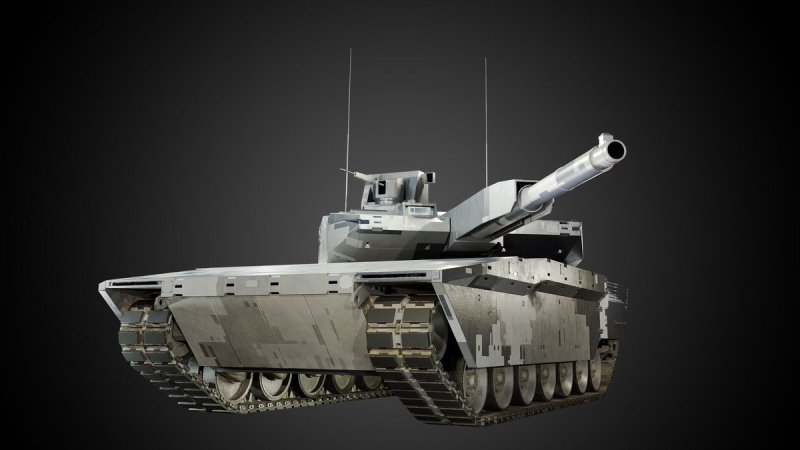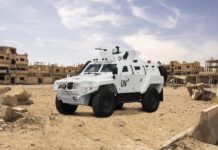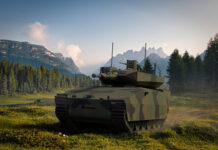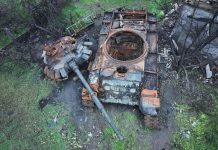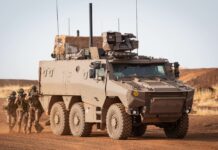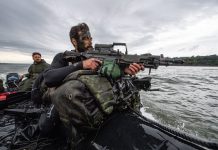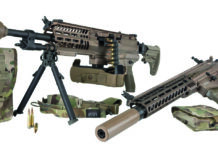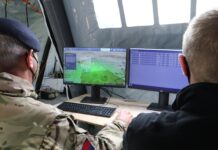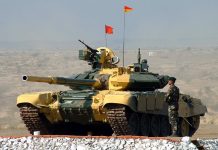Once an operational requirement for an armoured vehicle is formulated, one moves on to the design phase which is generally said to involve a compromise between three key factors; those being firepower, mobility and protection. To three broad categories one needs to add in sensors, electronics, including command, control, communications and computing, plus networks amongst other elements. The modern armoured vehicle truly is a system of systems these days, and consequently is a highly complex and sophisticated environment.
Ammunition Handling Background
Armoured vehicle design used to be a much more straightforward process, with a Main Battle Tank, for example, it was how big does the gun have to be in calibre terms to defeat current and projected threats, then it was how much space will the gun and its optical sights require in the armoured envelope of the tank, and then space has to be allocated for those who serve the gun (gunner and loader). This then brings us to much space is available on the tank for ammunition, obviously the larger the calibre of the main gun, generally its ammunition will require significant space, it being necessary to accommodate ammunition in ready racks around the turret/fighting compartment for immediate use and to store ammunition elsewhere that can be accessed without too much difficulty to replenish ready racks as necessary.
There is more to come though: you have to accommodate the co-axial machine gun, a sight and its ready use ammunition, as well as extra ammunition boxes. If a Heavy Machine Gun (HMG) mount on the turret roof is specified, you then have to find space within the vehicle for substantially larger ammunition, normally 12.7×99 mm NATO (0.50 BMG) or 12.7×108 mm, the standard former Soviet round used by Russia and many others. There are those whose HMG enthusiasm requires an even larger calibre leading to the installation of a 14.5×114 mm KPV on the turret roof, certainly a powerful weapon, but storing its ammunition will take up even more space.
The armoured envelope of our notional tank is starting to fill up, but remember, you have to add the space for the commander and the appropriate vision systems for all of the crew. Then comes the communication equipment and intercom, plus all of the other bits of equipment that the tank crew will need. On a British tank there has to be space for a boiling vessel to provide the hot water for tea, amongst other things, while the Israeli MERKAVA tank has a chilled water dispenser in the turret. Of course, one cannot forget the driver, plus the propulsion and mobility systems that have to be accommodated on the tank.
Evolution
Thus far we have described a ‘generic’ tank, and, as you can see, there are so many factors that need to be taken into account in the design process. One of obvious solution to finding the space that you need to fit everything in is to have a larger vehicle, but bigger is not necessarily better! A bigger vehicle means more weight, it also means that more protection is needed to cover critical areas which also equals more weight. More weight means that you need a more powerful engine to move your vehicle, plus suspension modifications and other changes, that in turn equal more weight. You might have added to firepower and protection with a bigger vehicle, but that has come at the cost of mobility. Unbalanced armoured vehicle designs are rarely successful.
The somewhat basic tank design that we have sought to describe thus far, has evolved immensely in the modern era, current generation vehicles with their complex arrays of sights and sensors, plus immense computing power can engage targets at extended ranges in day/night conditions offering high first-round kill probabilities. Of course, that means that there are even more things to fit within the armoured envelope and new issues emerge which armoured vehicle designers have to take into account.
Clearly the endgame with any tank design is to have most effective possible system within the constraints that are being operated under, these constraints could be diverse, ranging from cost to size and weight, operational considerations and even cultural factors. As a result, what passes as a good tank design in country A could be totally unacceptable in country B. Despite this, most tank designs have followed a pretty similar formula, yet there have been incidences of innovation.
In the early 1960s the then Soviet Army had developed a requirement for a new tank design that would supplement and then replace the T-62 and earlier model tanks. This led to the state-of-the-art T-64, the first true variant of which was equipped with a 125 mm smoothbore cannon fed by a 6ETS11 autoloader carrying 28 rounds of ammunition in APFSDS, HEAT and HE/HEF variants. These are two-piece rounds comprising of the projectile and a propellant charge which are loaded separately by the autoloader.
For political and economic reasons it was decided to sanction another tank programme in the shape of the T-72. Again, this had a 125 mm smoothbore cannon fed by an autoloader of a different design to that used in the T-64, with space for only 22 rounds of ammunition. Both the T-64 and the T-72 autoloaders were subsequently modified to load cannon-launched guided munitions, initially the 9K-112 and later the 9K-119/9K-130 systems and their evolutions. The later T-80 tank would also use an automatic loading system the 6ETS-15 KORZINA, while the T-72 autoloader would evolve to provide the system for the T-90. The future Russian T-14 ARMATA tank features an autoloader with a 32 round capacity for its 2A82-1M 125 mm gun.
From the perspective of the designers of the T-64 and the T-72, the use of an autoloader made a great deal of sense, an autoloader meant that the loader could be dispensed with, meaning that the internal volume of the tank could be reduced. Add that to the fact that nobody was really interested in ergonomics in this design process, and the end result was a tank with a reduced visual signature, but not necessarily one that was easier to fight in.
The fact that Soviet designers and their successors in Russia and the Ukraine have kept faith with autoloaders demonstrates that they have many positive operational characteristics. The vulnerability of T-72s to catastrophic damage in combat in the Middle East does not negate the Soviet preference for autoloader systems. There is no getting away from the fact that a tank is a steel box full of flammables, whether it be fuel, hydraulics, lubricants or ammunition, if the vehicle is penetrated the end result is generally not pretty. Soviet export tanks had significantly reduced armour arrays compared to the protection afforded to domestic tanks, the end result being that penetrations usually led to unpleasant consequences.
Other Options
One characteristic of modern tanks is that their service lives can be greatly extended. These days a minimum life of 30 years is expected and most often exceeded. This creates a requirement to upgrade vehicles to increase their capabilities and to deal with current and projected future threats. Upgrades could be very straightforward, for example the ability to use a higher performance ammunition nature. However, an upgrade of this type would be complicated if you had T-series tanks with a carousel autoloader. An APFSDS variant with an extended penetrator would require significant alterations to the autoloader to be accommodated.
As previously discussed, within the armoured envelope of a tank, space is at a premium. That being said, the replacement of 1980s era components with modern systems can win a surprising amount of space in the turret, taking into account human factors and ergonomics can also allow the available space to be used much more efficiently. Sometimes though, you have to accept the fact that the required serious upgrades for tank are going to be more complicated and more expensive than anticipated. This certainly was the case in the British Army CHALLENGER 2 upgrade programme.
The CHALLENGER 2 entered service with the British Army in 1998. The main gun was the 120 mm L30A1 L/55 rifled system that used two-piece ammunition, but it became apparent that the rifled gun was not the way forward as everybody else in NATO had opted for 120 mm smoothbore. This led to the CHALLENGER Lethality Improvement Programme (CLIP), an effort that saw the installation of the Rheinmetall 120 mm smoothbore gun into the CHALLENGER 2. As a programme, CLIP obtained no traction and then came the CHALLENGER 2 Capability Sustainment Programme (C2 CSP), another upgrade effort that led nowhere.
Eventually the British Army decided that it really wanted a CHALLENGER 2 upgrade programme and this led to the CHALLENGER 2 Life Extension Programme (CR 2 LEP), which grew in scope and cost as the programme evolved. Remarkably for a British armour programme managed to get to the contract award stage, with Rheinmetall BAE Systems Land (RBSL) receiving an £800 million contract in May 2021 to upgrade 148 tanks to the CHALLENGER 3 configuration.
The CHALLENGER 3 programme upgrades the firepower, mobility and protection aspects of the tank. In terms of firepower, the installation of the Rheinmetall L55A1 120 mm smoothbore gun and its associated ammunition could not be accommodated in the existing CHALLENGER 2 turret, consequently a new turret developed by Rheinmetall was selected and installed in place of the original turret.
French Perceptions
France saw the advantage of automatic loading systems many years ago, indeed they started working on a system in this category for the AMX-13 light tank all the way back in 1946! The AMX-13 had a 75 mm main gun which was fed via an automatic loader from two six-round magazines in the bustle of the FL-10 turret of the tank. However, it was to be many years later before there was a resurgence of interest in autoloaders for French tanks.
In the 1980s the French Army was looking for a successor to its AMX-30 tank. Initially this need was to be met by a joint venture tank developed with Germany. The collaborative programme failed and a national programme was instituted instead, the new tank would be far better protected than its predecessor and it would also have far more in the way of firepower.
The resulting LECLERC tank was equipped with a 52-calibre 120 mm CN120-26 smoothbore gun, capable of utilising a complete family of French APFSDS, HEAT and HE variants. In addition, the French gun can utilise all standard NATO 120 mm smoothbore natures. Where the LECLERC was unique for western tanks of that era is that the decision was taken to opt for a three-man crew and an autoloader. The autoloader has space for 22 rounds, with there being an additional 18 rounds onboard to restock the autoloader.
With a 120 mm main gun there are reasons both for and against manual loading and for and against autoloading. In the next generation of western tanks, such as the Franco-German Main Ground Combat System (MGCS), this will be equipped with a successor to the 120 mm smoothbore, for example Rheinmetall in Germany have 130 mm smoothbore in development, while France developed a 140 mm smoothbore in the 1990s. Once you move up to 130 or 140 mm calibre, the attractions of an autoloader system are obvious. As a result, French operational experience with autoloader systems will be key to MGCS.
The need to confront increasing threat capabilities with larger calibre weapons is not only confined to tanks. Increasingly thought is being given to enhancing the firepower available to Infantry Fighting Vehicles (IFV), these days the minimum cannon calibre is 30 mm, but increasingly interest is being shown in larger calibres such as 40 mm, 50 mm or even larger. The risk with all of this is that in the constrained space of an IFV, accommodating a larger calibre gun and its ammunition will mean compromises will have to be made, this could be less ammunition carried, fewer dismounts or reduced capability in other areas. Both for IFVs and tanks, you can add more firepower but you will have to make difficult choices in the process.


